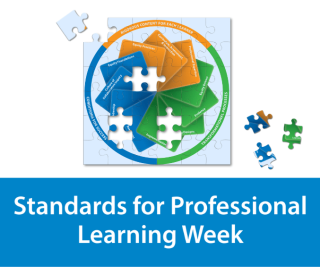The Redesign PD Community of Practice engages teams from 22 of the nation’s leading school districts and charter management organizations in identifying local professional learning challenges and creating scalable solutions. Learning Forward facilitates the community, where teams participate in continuous learning cycles to improve how they manage their professional learning systems.
Bridgeport (Connecticut) Public Schools joined Learning Forward’s Redesign PD Community of Practice to improve the impact of professional learning throughout the district.
We are two of the district’s representatives participating in the Redesign PD Community and storytellers of our progress. With other members of the Bridgeport redesign team, we are seeking ways to build coherent and relevant professional learning within and across district improvement efforts.
For us, coherent professional learning addresses district learning goals consistently across all levels of the district, shows key intentional design elements, and follows the Standards for Professional Learning. Relevant professional learning is useful to teachers, timely, and related to their classroom practices
Common values identified in planning
Supported by our thought partners in the community, our team began by gathering input from various district staff. We reviewed research, the Standards for Professional Learning, and current practices across the nation. We also conducted surveys, focus groups, tabletop exercises, and professional learning sessions with our staff to identify highly valued areas of practice as well as opportunities for growth.
When we analyzed results, we saw that teachers and administrators seemed to be coming from a common value system related to professional learning. Both groups agreed that coherence was an important problem to address.
The district developed a new professional learning planning template to ensure a coherent process, and each school established a professional learning committee. Every administrator completed a self-assessment of the process and provided it to the redesign team to be used for planning and support.
Meanwhile, early adopters such as the literacy department used the new process with cohorts of teachers. Already, they are seeing promising results for staff and students. As we develop our abilities to plan more coherent and relevant professional learning, we continue to refer to the following learning design principles: collaborative, ongoing, targeted, and grounded in classroom-based student learning metrics.
Coherence supported by collaborative learning
The development of a more collaborative culture of learning has been the foundation for the emergence of coherence. And since collaboration emerged as a prevailing response during the surveys and staff conversations, the literacy department launched a series of workshops with a cohort of 30 middle school English language arts teachers.
The sessions provided opportunities for collaboration among the teachers. For example, Kathleen McCaughey, who is the only 7th-grade English language arts teacher at her school, says that the professional learning sessions this year allowed her to connect with other 7th-grade teachers. She also says that professional learning this year helped make the curriculum come to life.
Feedback about teacher learning needs
To foster ongoing learning in each school, monthly English language arts department meetings extended teacher learning, and school-based literacy coaches supported professional learning. At the end of each session, coaches polled teachers, asking, “What kind of follow-up on today’s professional learning would you want?”
The top three themes were: collaborative scoring and analysis of student work, creating a writing pacing guide, and building selected and constructed responses that also corresponded to the criteria in the district planning template.
Relevance built into teacher learning
Using the learning design curriculum as professional learning, which is described in Powerful Designs for Professional Learning (Learning Forward, 2015), we created “Up Close and Purposeful: Evidence-Based Reading and Writing Series.” We developed workshop objectives using performance and computer adaptive assessments to support improvement efforts.
In the spirit of Learning Forward’s mission, “Excellent teaching and learning every day,” more than half of the English language arts teachers participating in the professional learning series expressed increased awareness about the impact of their practice on teaching and learning as measured by the end-of-session questionnaires.
Focus on short- and long-term impact
At the December 2016 Redesign PD Community of Practice convening, Tom Guskey told the group that we should plan professional learning with the end in mind. That end, he told us, is student learning. Because we had solicited — and listened to — teacher feedback throughout our planning, we focused the final professional learning session on practices that would allow teachers to enhance student learning in literacy.
Early results on a nationally normed assessment indicated that our 7th- and 8th-grade students demonstrated a year’s worth of learning within five months of instruction supported by our intentionally designed professional learning. Although our district problem of practice focuses primarily on coherent and relevant professional learning for teachers, our experience confirms Guskey’s point that a focus on student learning should be an element of coherent and relevant professional learning as evidenced by teacher feedback and preliminary student outcomes.
The middle school teachers show that intentionally designed professional learning can make a difference for them and their students. As we scale up the process across the district, these promising results will drive our efforts to strengthen coherence and relevance. We will monitor and share our experiences with our community of practice for feedback and future planning.
This post originally appeared in Learning Forward’s PD Watch.







